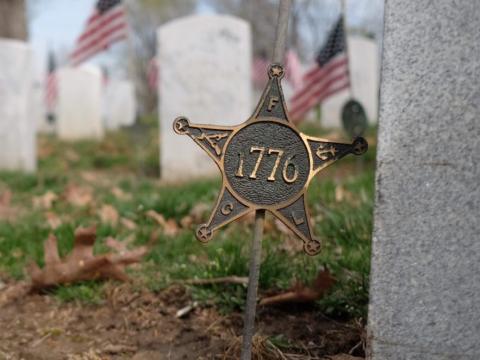Centuries later, Revolutionary War veteran resting places get recognition in Ohio

Listen to this Episode
Despite the fact Ohio did not exist as a state during the Revolutionary War, it's become the final resting place for more than 7,000 patriots who fought for U.S. independence.
Their graves are scattered all across the state, but Ohio lacks a complete record of where they are and what condition they're in.
The Ohio History Connections hopes to change that. In preparation for the nation's 250th anniversary next year, a new project hopes to ensure these founding soldiers' graves – from captains in Wooster to minutemen in Lima – are not only documented but available in a public database and interactive map.
"What we're hoping is that local communities, school groups, educators can use this to really be able to jumpstart their own research or their own preservation projects for these veterans," said Krista Horrocks, a cemetery preservationist and coordinator of the Ohio History Connection project.
Why are there so many patriots here?
Shortly after the Revolutionary War was won, many newly-branded Americans set their sights on the Northwest Territory.
During the war, Congress had little money to pay soldiers. So they created an incentive: fight in exchange for land. Two areas in the Ohio region were reserved explicitly for veterans. Patriots cashed in on that promise, making Ohio their home.
Among them was Nathaniel Massie, a surveyor who's credited with founding numerous towns in the state, including Chillicothe, the state's first capital. When the project launched this spring, the private's grave became the first documented in the Ohio History Connection's Revolutionary War Veteran Graves Identification and Recognition Project.
"He is arguably one of the most well-known Revolutionary War veterans here in Ohio. He made a huge impact just in terms of Ohio being established and being surveyed."
How to get involved
Now, Horrocks said Massie's grave is just one of around 1,000 graves across more than 200 cemeteries that have been documented, thanks to Ohioans volunteering as public researchers.
But there's still more to do. Horrocks said anyone can get involved. The organization's website provides instructions on how to use an app, called Survey123, to add to the growing list of graves. Plus, there's a cemetery map with leads on where to find potential Revolutionary War burial places.
"You can look in your area and say, 'I know that cemetery, it's right down the street from my house.' And then do a little bit of research through websites like Find a Grave to really find out where the veteran is and then go out and document them through our process," Horrocks said.
How will this map help?
The records go directly to a live results map. Horrocks said the database will have the GPS coordinates of Ohio's revolutionary war graves all in one centralized place.
"The local [Daughters of the American Revolution] and [Sons of the American Revolution] groups [and other] historical societies can take this information and go out and say, 'Now we know exactly where our veterans are,'" she said.
The information is especially important to document because, Horrocks said, these graves are centuries old. In order to take care of them, the state needs to have the tools to monitor them.
Through the project, she hopes more Ohioans take the time not only to remember the contributions of America's first veterans, but to rally to protect their resting places.
"A lot of [the graves] are in really bad shape," she said "So, now, it makes people go, 'Wow, I wanna do something about this. Let's look at raising funds. Let's look at talking to our local community or local legislators, let's prioritize this.'"
"These are people who helped shape our country."
- Home
- Schedules
- TV
- TV
- Local TV Programs
- Business | Life 360 with Kristi K.
- Toledo Stories
- To The Point with Doni Miller
- Listening with Keith Burris
- Ideas & Insights
- WGTE Presents
- BL360: Northwest Ohio Innovation Consortium
- Magic of the Old West End
- Freedom Means Never Surrender
- I&I: The Random Factor
- FF: National Cherry Festival
- TTP: Moms Demand Action For Gun Sense in America
- Watch Live
- Radio
- Education
- Community
- Support
- About
- Donate
- Watch Live


